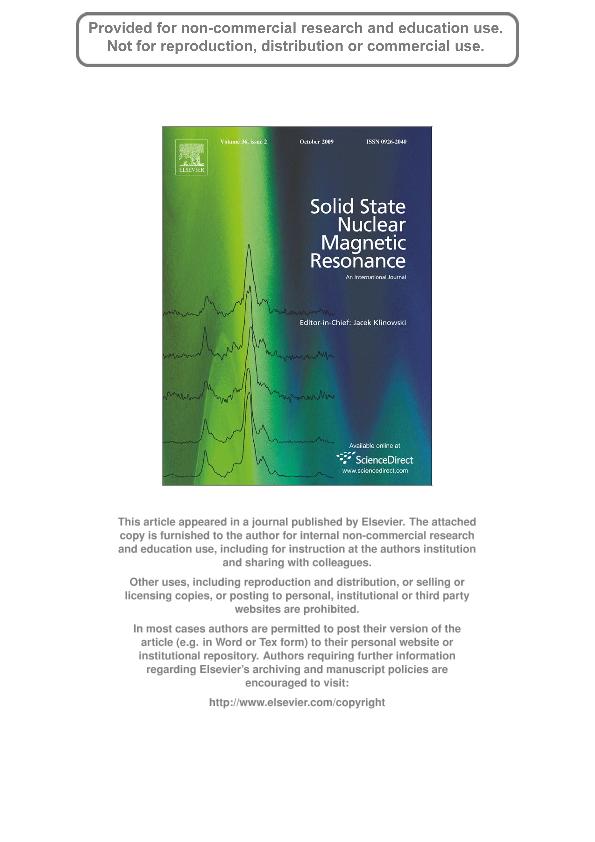Artículo
NMR dipolar constants of motion in liquid crystals: Jeener-Broekaert, double quantum coherence experiments and numerical calculation on a 10-spin cluster
Segnorile, Hector Hugo ; Bonin, Claudio Julio
; Bonin, Claudio Julio ; González, Cecilia Élida; Acosta, Rodolfo Héctor
; González, Cecilia Élida; Acosta, Rodolfo Héctor ; Zamar, Ricardo César
; Zamar, Ricardo César
 ; Bonin, Claudio Julio
; Bonin, Claudio Julio ; González, Cecilia Élida; Acosta, Rodolfo Héctor
; González, Cecilia Élida; Acosta, Rodolfo Héctor ; Zamar, Ricardo César
; Zamar, Ricardo César
Fecha de publicación:
12/2009
Editorial:
Elsevier
Revista:
Solid State Nuclear Magnetic Resonance
ISSN:
0926-2040
Idioma:
Inglés
Tipo de recurso:
Artículo publicado
Clasificación temática:
Resumen
Two proton quasi-equilibrium states were previously observed in nematic liquid crystals, namely the S and W quasi-invariants. Even though the experimental evidence suggested that they originate in a partition of the spin dipolar energy into a strong and a weak part, respectively, from a theoretical viewpoint, the existence of an appropriate energy scale which allows such energy separation remains to be confirmed and a representation of the quasi-invariants is still to be given. We compare the dipolar NMR signals yielded both by the Jeener?Broekaert (JB) experiment as a function of the preparation time and the free evolution of the double quantum coherence (DQC) spectra excited from the S state, with numerical calculations carried out from first principles under different models for the dipolar quasiinvariants, in a 10-spin cluster which represents the 5CB (40-pentyl-4-biphenyl-carbonitrile) molecule. The calculated signals qualitatively agree with the experiments and the DQC spectra as a function of the single-quantum detection time are sensible enough to the different models to allow both to probe the physical nature of the initial dipolar-ordered state and to assign a subset of dipolar interactions to each constant of motion, which are compatible with the experiments. As a criterion for selecting a suitable quasi-equilibrium model of the 5CB molecule, we impose on the time evolution operator consistency with the occurrence of two dipolar quasi-invariants, that is, the calculated spectra must be unaffected by truncation of non-secular terms of the weaker dipolar energy. We find that defining the S quasiinvariant as the subset of the dipolar interactions of each proton with its two nearest neighbours yields a realistic characterization of the dipolar constants of motion in 5CB. We conclude that the proton-spin system of the 5CB molecule admits a partition of the dipolar energy into a bilinear strong and a multiple-spin weak contributions therefore providing two orthogonal constants of motion, which can be prepared and observed by means of the JB experiment. This feature, which implies the existence of two timescales of very different nature in the proton-spin dynamics, is ultimately dictated by the topology of the spin distribution in the dipole network and can be expected in other liquid crystals. Knowledge of the nature of the dipolar quasi-invariants will be useful in studies of dipolar-order relaxation, decoherence and multiple quantum NMR experiments where the initial state is a dipolar ordered one.
Archivos asociados
Licencia
Identificadores
Colecciones
Articulos(INTEC)
Articulos de INST.DE DES.TECNOL.PARA LA IND.QUIMICA (I)
Articulos de INST.DE DES.TECNOL.PARA LA IND.QUIMICA (I)
Citación
Segnorile, Hector Hugo; Bonin, Claudio Julio; González, Cecilia Élida; Acosta, Rodolfo Héctor; Zamar, Ricardo César; NMR dipolar constants of motion in liquid crystals: Jeener-Broekaert, double quantum coherence experiments and numerical calculation on a 10-spin cluster; Elsevier; Solid State Nuclear Magnetic Resonance; 36; 2; 12-2009; 77-85
Compartir
Altmétricas



